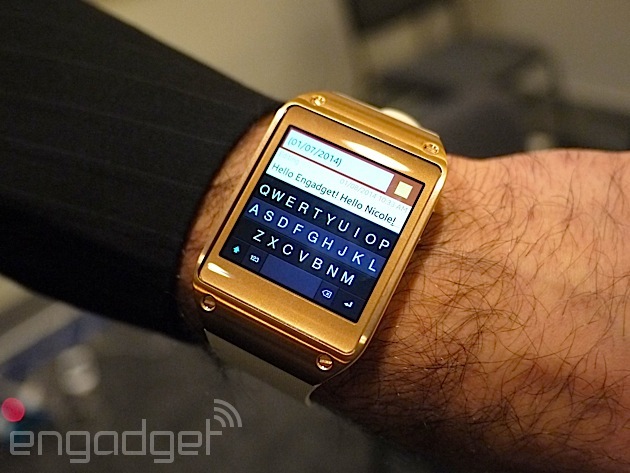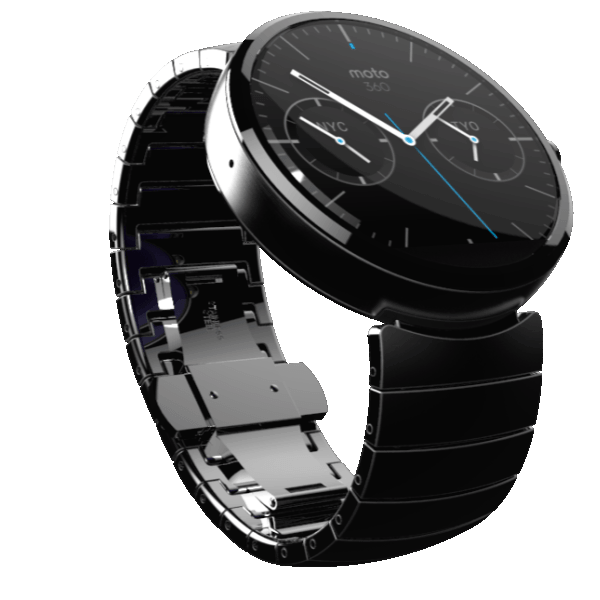Top 5: Why Android Wear is so exciting
 |
| Image: Engadget |
5. No keyboard input
Smartwatches are small. They don't come with large 5" displays like our phones do. So why would you want to type using a keyboard on such a small display? It just doesn't make sense. From the videos we've seen of Android Wear, there are only two possible input methods - voice and swipe gestures (or taps). No keyboard was in sight in any of the videos, which to me is a vital component in ensuring the user experience is both enjoyable and fluid. Voice input is getting better and better, and if smartwatches are products of the future, it only makes sense that your voice be the main source of input.
 |
| No thank you. Image: Engadget |
4. Device compatibility
One of the main gripes everyone had with the original Galaxy Gear smartwatch was that it only worked at launch, with the Note 3. Eventually more devices were compatible with it, but again, only Galaxy devices. Being open in nature, Android Wear-powered smartwatches will likely work with any Android device, regardless of who actually made the watch and what phone you currently use. Who knows, it might even work with iPhones. Chromecast works with iOS devices, and so does Google Glass, so it's not illogical to think that Android Wear could also be iOS-compatible too, if not now maybe in the future.
3. Sexy hardware
We've only seen two smartwatches so far that will be running Android Wear - LG's G Watch and Motorola's Moto 360. The G Watch looks pretty sleek, but it's just not as sexy as the 360. We care about how our smartphones look, but most of the time they are either in the palm of our hands or our pockets. A watch on the other hand is a fashion accessory. It's always there on your wrist for people to see. Pebble learned how important looks are for a smartwatch, making the Pebble Steel look so much better than the original Pebble. If other OEMs get on board with Motorola's design philosophy, and if proper watch makers get on board with Android Wear too, we will be getting some seriously beautiful hardware in the future.
 |
| Such sexy. Much nice. Image: Droid-Life |
2. The market has matured
Back in 2007, iOS made smartphones as we currently know them a reality. A year later, we got Android. Both were very immature at the time, yet over the years they have grown and blossomed into excellent pieces of software, powering 95% of the world's smartphones. The advantage smartwatches running Android Wear will have over smartphones, is that they will begin with software that is already mature (for the most part). Software that most people will already be familiar with. We are already used to touching displays to control our devices. We are comfortable using voice commands. The awkwardness of using a "smart" device in public that plagued the initial penetration of smartphones into our society should not be a problem with smartwatches. Using a smartwatch should come as second nature to most people, and that will help the industry grow at a rapid pace.
1. Google Now
Google Now will forever be one of the greatest innovations of our time. Having information provided to you when you need it, without having to ask for it is basically putting the "smart" in smartphones. And it will now put the smart in smartwatches. Having relevant information on your wrist is extremely useful, especially for people who are regularly working with both hands and find it burdensome to have to take their phone out of their pocket to see what notification they just received. With Google Now powering your smartwatch, you could be having lunch with friends, get a beep on your watch, take a quick glance and see that you need to leave now to make your meeting back at the office, and be on your way. Like I said, smart.
 |
| Google Now will make smartwatches worthwhile. Image: Motorola Blog |
There will be those who don't see any use for a smartwatch. And that's fine. Like tablets and Google Glass, not everyone will be able to fully utilise a smartwatch. It depends entirely on your "smart device" usage. If you rarely use Google now, Android Wear on a watch will be pretty useless to you. But if you're a busy bee with lots of meetings, constantly travelling around the city and getting emails every minute of the day, a smartwatch could really be helpful. Especially if it's running Android Wear. It's still early days yet, we only have developer previews of the software and two devices waiting to be announced, but based on what we already know, you would have to be a brave soul to bet against Android Wear dominating the smartwatch market the same way Android does the smartphone market. Google I/O can't come soon enough.



Comments
Post a Comment